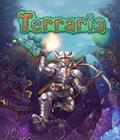At first glance, Terraria is a deceptively simple experience. You start with a basic tutorial, a pickax and a world to explore. Instructions are minimal, graphics are blocky, and you can do little more than fight enemies and dig holes. It isn't until you've been playing for a few hours that Terraria really opens up and you start to realize how incredibly complex (and somewhat addicting) this game can be.
Originally built for the PC by a two-man team (in six months, no less), Terraria looks as though it could have walked right out of the 16-bit generation with its colorful pixel art and straightforward gameplay. Easy to learn and difficult to master, Terraria is a time sink that is likely to keep you playing until the wee hours of the morning.
There really isn't a story in Terraria, per se. Instead, the goal is to explore and build. As you adventure through the world or dig down toward the core, you'll explore various types of environments ranging from desert to jungle to dungeon and containing all manner of creatures. Monsters are weakest near your starting position and get progressively stronger the farther away you go. In order to survive, you'll need to improve your stats by crafting weapons and armor.
Crafting is done by acquiring raw materials and then merging them at the appropriate crafting area, such as a workbench or an anvil. Actually doing the crafting is the easy part. Finding the raw materials is where the challenge comes in. Most of what you'll need is underground, and that means digging. Lots and lots of digging.
Because the worlds of Terraria are randomly generated, everyone plays in a similar, yet different world. There is no way to know what's down below until you start exploring. Even then, you need to be prepared because it's dark in the depths. If you forget to bring torches, you won't even be able to see what you're doing.
Dirt and stone are the two most common items to dig through, though most players will quickly find veins of copper and iron ore once they start mining. Gold and silver are less common but still not considered rare. That's left for some made-up elements, which are used to craft the most powerful items in Terraria. What keeps the exploration interesting is that the ground isn't just a solid block. Instead, as you explore underground, you will find caves, lakes, lava, tunnels — and more enemies to fight.
Water is an intriguing element in Terraria because it always flows downward. This can be advantageous, as it means you can easily drain a lake if necessary, but it can also be problematic if you're not careful. Opening up a lake at the wrong spot can quickly flood one of your mine tunnels, snuffing out every torch along the way. Getting trapped underwater is also an easy way to die via drowning.
Adding to the creative aspect in Terraria is your ability to build stuff within the world. Just as you can use raw materials to craft items, you can also use the raw materials that you mine (and craft) to build custom structures in the world. Homes are a safe place for you to take refuge during the night (when enemies are stronger). They are also necessary if you want to attract NPCs to your world. Build the homes, and they will come. Having NPCs around is always useful. One good example is the merchant. Sometimes it's quicker to buy something you need rather than trying to find or craft it.
When you start Terraria, it is likely that your building skills will be rather basic. In reality, building is pretty much limited only by your imagination. It is possible to create some crazy intricate designs so long as you have the patience and the resources.
In addition to the single-player experience, Terraria also offers multiplayer. Up to four players can explore via split-screen, and up to eight can go at it online. Both co-op and competitive play are an option, depending on your preference. When moving between worlds, all of your character's loot goes with you, so this is a straightforward way to trade in-game items with friends. Unfortunately, there don't seem to be too many people playing Terraria online in open games, as the only servers we were able to find were set up by staff members.
Where Terraria stumbles a bit is in the difficulty level. As a game, it doesn't really ease the player into anything. For gamers who grew up on action games, this isn't a big deal. For casual gamers who may be drawn to Terraria's world-building elements, it can be a big drag since you're woefully underpowered when the game starts. There's also no real hand-holding in terms of crafting or what you're supposed to do next. It's pretty much sink-or-swim from the outset. It's really too bad that the game doesn't offer a no-enemy sandbox mode for the casual set.
With that said, if you're the type who doesn't mind charging ahead blindly, Terraria can be a wonderful experience. Yes, there will be spikes of difficultly, but the joy in discovering a creative solution to a boss fight or stumbling across a new recipe is hard to deny. The desire to search for better loot reminded us a lot of Blizzard's PC classic, Diablo II.
Part action game, part LEGO playset, Terraria is more or less Dig Dug taken to the extreme. The first hour or so is slow going, but once Terraria opens up, it can be very difficult to put down.
Score: 8.0/10
More articles about Terraria











 Terraria is a side-scrolling, action-adventure sandbox game, with an emphasis on crafting and exploration set in vast and vibrant worlds.
Terraria is a side-scrolling, action-adventure sandbox game, with an emphasis on crafting and exploration set in vast and vibrant worlds.





















